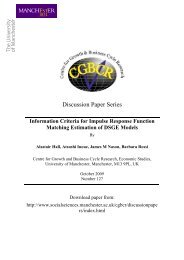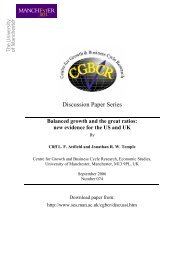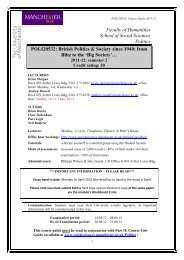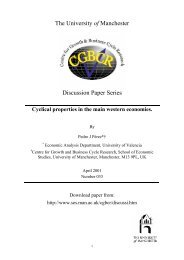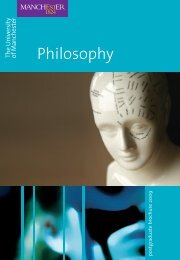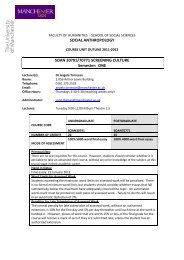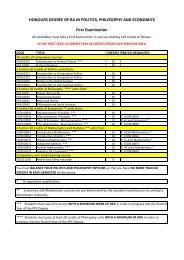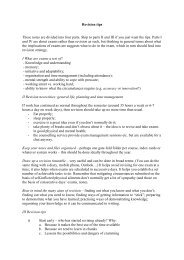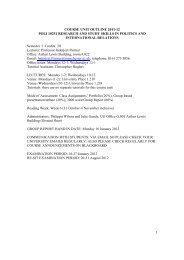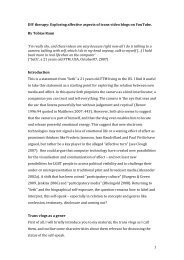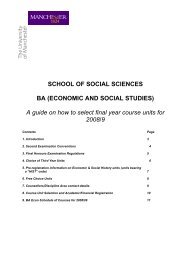CHNN 22, Spring 2008 - School of Social Sciences
CHNN 22, Spring 2008 - School of Social Sciences
CHNN 22, Spring 2008 - School of Social Sciences
Create successful ePaper yourself
Turn your PDF publications into a flip-book with our unique Google optimized e-Paper software.
to entirely go along with Cohen’s characterisation <strong>of</strong> it as developing in the direction <strong>of</strong> a ‘think<br />
tank’ in the 1920s under the chairmanship <strong>of</strong> Clifford Allen. It was surely much more than this. For<br />
a start, it was much bigger than most organisations designated in this way today. It was more than<br />
five times the size <strong>of</strong> the CPGB at the time <strong>of</strong> disaffiliation in 1932 as we are reminded in the very<br />
first sentence <strong>of</strong> the introduction.<br />
Cohen rejects the view that disaffiliation was simply an act <strong>of</strong> ‘insanity’. But he is clear that most<br />
ILPers would have preferred to remain affiliated and that the majority <strong>of</strong> members who supported<br />
disaffiliation came to this position with the greatest reluctance. As late as the beginning <strong>of</strong> 1932, the<br />
year <strong>of</strong> the breach with Labour, six <strong>of</strong> the nine ILP divisions, accounting for about 80 per cent <strong>of</strong><br />
the membership, voted to remain affiliated to Labour at their meetings preceding the party’s<br />
national conference. Yet within a quite short period thereafter the decision to disaffiliate was taken,<br />
with the result that about a third <strong>of</strong> the membership departed. So, why, if there was so much<br />
reluctance to part company with Labour and so much opposition to doing so, did the delegates to<br />
the crucial conference resolve on disaffiliation?<br />
There were groupings, notably the ‘Revolutionary Policy Committee’ formed the previous year,<br />
which had their own reasons for supporting disaffiliation; but Cohen is clear that the key role was<br />
played by the conflict over the standing orders <strong>of</strong> the Parliamentary Labour Party. This went back<br />
to 1929 after a period when the more militant ILP MPs, notably Maxton, had been fierce left-wing<br />
critics <strong>of</strong> the Labour leadership and, from the latter’s point <strong>of</strong> view, had signally failed to display<br />
the loyalty it expected from its parliamentary supporters. Incompatible decisions by both parties<br />
were then taken. The ILP for its part resolved that all ILP MPs and candidates should formally<br />
undertake to support the policies determined by its conferences while the Parliamentary Labour<br />
Party introduced new standing orders which precluded MPs from voting against the decisions <strong>of</strong><br />
the PLP. This might have seemed something that concerned mainly the ILP parliamentary group;<br />
but when at by-elections and subsequently the general election <strong>of</strong> 1931 Labour failed to endorse<br />
ILP candidates – nineteen <strong>of</strong> them at the general election – resentment and anger were widespread<br />
among their supporters.<br />
Nevertheless, at the regular ILP annual conference in 1932 delegates voted against immediate<br />
disaffiliation and resolved by a very large majority to re-open negotiations with Labour on a<br />
compromise solution for the standing orders conflict. This was, says Cohen, ‘a victory for the<br />
politics <strong>of</strong> Micawber’. Labour had already made it crystal clear that it was not prepared to give any<br />
ground at all on the question and the hope that something would turn up to rescue the ILP from its<br />
dilemma was doomed to failure. A special conference in July 1932 bowed to the inevitable and took<br />
the decision to disaffiliate. But it would have been interesting to hear a little more about exactly<br />
how the decision to call the ‘disaffiliation conference‘ was made. And anyone could be forgiven for<br />
wondering how the Labour Party, so soon after the MacDonald defection and the disastrous 1931<br />
election – which reduced its number <strong>of</strong> MPs from the 287 won in 1929 to just forty-six – could<br />
contemplate the loss <strong>of</strong> the ILP so calmly.<br />
One outspoken supporter <strong>of</strong> the ILP line on the standing orders was the veteran ILPer and former<br />
MP, and indeed former minister, Fred Jowett. For him what was at issue was the electorate’s right<br />
to elect MPs who would honour the pledges made during the campaign – in the case <strong>of</strong> those<br />
supported by the ILP, the policies determined by the party’s conference. Again, it would have been<br />
very interesting if these arguments had been explored further. Jowett had a long record as a critic<br />
<strong>of</strong> what passed for representative government going back well before the Great War. He had<br />
doggedly pursued the celebrated ‘Bradford Resolution’ for years and – though he served in<br />
MacDonald’s first cabinet – continued to advocate the replacement <strong>of</strong> cabinet government by a<br />
committee system. His position on the PLP standing orders was closely related to his more general<br />
stance on democracy. So much is clear from Brockway’s account in his biography <strong>of</strong> Jowett. How<br />
big a part did this play in ILP attitudes more generally at the time <strong>of</strong> disaffiliation?<br />
As far as ILP membership is concerned, the book presents a more nuanced picture than the usual<br />
one <strong>of</strong> inevitable and precipitate decline. Significant fluctuations in membership were new neither<br />
to the ILP nor to other left-wing parties where, for example, the CPGB suffered a much greater<br />
percentage <strong>of</strong> loss during the first ten months <strong>of</strong> the disaffiliated ILP. What was more worrying for<br />
the ILPers that remained was that membership continued to fall by slightly larger proportions in<br />
the following two years. And as a result <strong>of</strong> serious declines in old strongholds such as Lancashire,<br />
51



